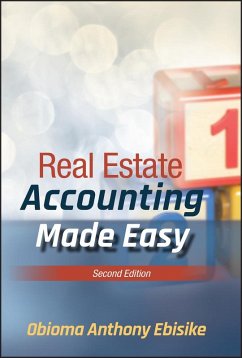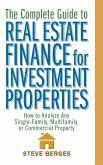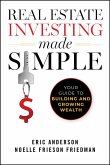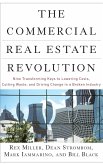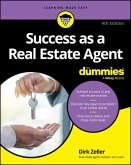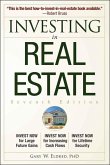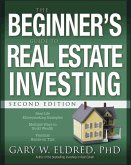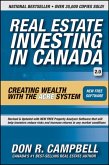Obioma A. Ebisike
Real Estate Accounting Made Easy
Obioma A. Ebisike
Real Estate Accounting Made Easy
- Gebundenes Buch
- Merkliste
- Auf die Merkliste
- Bewerten Bewerten
- Teilen
- Produkt teilen
- Produkterinnerung
- Produkterinnerung
A practical guide to the field of real estate accounting and finance.
Andere Kunden interessierten sich auch für
![The Complete Guide to Real Estate Finance for Investment Properties The Complete Guide to Real Estate Finance for Investment Properties]() Steve BergesThe Complete Guide to Real Estate Finance for Investment Properties35,99 €
Steve BergesThe Complete Guide to Real Estate Finance for Investment Properties35,99 €![Real Estate Investing Made Simple Real Estate Investing Made Simple]() Eric AndersonReal Estate Investing Made Simple26,99 €
Eric AndersonReal Estate Investing Made Simple26,99 €![The Commercial Real Estate Revolution The Commercial Real Estate Revolution]() Rex MillerThe Commercial Real Estate Revolution38,99 €
Rex MillerThe Commercial Real Estate Revolution38,99 €![Success as a Real Estate Agent for Dummies Success as a Real Estate Agent for Dummies]() Dirk ZellerSuccess as a Real Estate Agent for Dummies26,99 €
Dirk ZellerSuccess as a Real Estate Agent for Dummies26,99 €![Investing in Real Estate Investing in Real Estate]() Gary W. EldredInvesting in Real Estate26,99 €
Gary W. EldredInvesting in Real Estate26,99 €![The Beginner's Guide to Real Estate Investing The Beginner's Guide to Real Estate Investing]() Gary W. EldredThe Beginner's Guide to Real Estate Investing28,99 €
Gary W. EldredThe Beginner's Guide to Real Estate Investing28,99 €![Real Estate Investing in Canada Real Estate Investing in Canada]() Don R. Campbell (Don R. Campbell is president of the Real Estate InReal Estate Investing in Canada38,99 €
Don R. Campbell (Don R. Campbell is president of the Real Estate InReal Estate Investing in Canada38,99 €-
-
-
A practical guide to the field of real estate accounting and finance.
Hinweis: Dieser Artikel kann nur an eine deutsche Lieferadresse ausgeliefert werden.
Hinweis: Dieser Artikel kann nur an eine deutsche Lieferadresse ausgeliefert werden.
Produktdetails
- Produktdetails
- Verlag: John Wiley & Sons Inc
- 2 ed
- Seitenzahl: 208
- Erscheinungstermin: 19. Dezember 2019
- Englisch
- Abmessung: 158mm x 235mm x 23mm
- Gewicht: 420g
- ISBN-13: 9781119626817
- ISBN-10: 1119626811
- Artikelnr.: 56713709
- Herstellerkennzeichnung
- Libri GmbH
- Europaallee 1
- 36244 Bad Hersfeld
- gpsr@libri.de
- Verlag: John Wiley & Sons Inc
- 2 ed
- Seitenzahl: 208
- Erscheinungstermin: 19. Dezember 2019
- Englisch
- Abmessung: 158mm x 235mm x 23mm
- Gewicht: 420g
- ISBN-13: 9781119626817
- ISBN-10: 1119626811
- Artikelnr.: 56713709
- Herstellerkennzeichnung
- Libri GmbH
- Europaallee 1
- 36244 Bad Hersfeld
- gpsr@libri.de
OBIOMA ANTHONY EBISIKE is an economist, certified public accountant (CPA), and a chartered accountant. He holds a PhD in Economics (with honors) from The New School for Social Research, a Master's degree in Real Estate Finance and Investments from New York University, and a Bachelor's degree in Accounting (Magna cum Laude) with minors in Finance and in Economics from The College of Staten Island, The City University of New York. Dr. Ebisike has extensive work experience and has held senior management positions at industry leading firms, such as Douglas Elliman Real Estate, ICON Investments, Hines Interests LP and was an Audit and Advisory Services Manager at Deloitte & Touche LLP. Dr. Ebisike is a faculty member at the NYU Real Estate Institute. He is also the author of The Fallouts: Banks and Financial Crises. He lives in New York City.
About the Author xi
Preface xiii
Chapter 1 Introduction to Real Estate 1
Types of Real Estate Assets 1
Common Industry Terms 8
Chapter 2 Basic Real Estate Accounting 17
History of Double-Entry Bookkeeping 17
Types of Accounts 18
Accounting Methods 22
Recording of Business Transactions in the Accounting System 23
Journal Entries 24
Basic Accounting Reports 26
Chapter 3 Forms of Real Estate Organizations 39
Sole Ownership 40
Common and Joint Ownership 40
Partnerships 41
Joint Ventures 43
Corporations 44
Limited Liability Companies 45
Real Estate Investment Trusts 46
Chapter 4 Accounting for Operating Property Revenues 49
Contracts with Multiple Components 49
Lease Classification 50
Lessor Accounting of Operating Leases 51
Types of Operating Leases 52
Additional Cost Recoveries 57
Operating Expenses Gross-Up 58
Contingent Rents 59
Rent Straight-Lining 60
Modification of an Operating Lease 65
Sublease of Operating Lease 67
Chapter 5 Accounting for Operating Property Expenses 69
Lessee Measurement and Recording of Operating and Finance Leases 70
Contracts with Multiple Components 71
Lease Liabilities and Right-of-Use Assets 73
Initial Direct Costs 74
Lessee Journal Entries of Operating and Finance Leases 75
Lessor Operating Property Expenses 81
Operating Costs 82
Chapter 6 Operating Expense Reconciliation and Recoveries 91
Most Common Recoverable Operating Expenses 92
Most Common Nonrecoverable Operating Expenses 92
Calculating Tenant Pro Rata Share of Expenses 93
Chapter 7 Lease Incentives and Tenant Improvements 97
Lease Incentives 97
Tenant Improvements 99
Tenant Improvement Journal Entries 99
Further Comparison of Lease Incentives and Tenant Improvements 100
Differences in Cash Flow Statement Presentation 101
Demolition of Building Improvement 101
Chapter 8 Budgeting for Operating Properties 103
What is a Budget? 103
Components of a Budget 103
Chapter 9 Variance Analysis 109
Sample Operating Property Variance Analysis 109
Salient Points on a Variance Analysis 112
Chapter 10 Market Research and Analysis 113
Market Research Defined 113
Market Analysis Defined 113
Market Research: Practical Process 114
Chapter 11 Real Estate Valuation and Investment Analysis 121
What is Real Estate Valuation? 121
Approaches to Real Estate Valuation 122
Chapter 12 Financing of Real Estate 133
Equity 133
Debt Financing 133
Other Financing Sources 136
Types of Loans 137
Debt Agreements 137
Financing Costs 141
Relationship Between a Note and a Mortgage 142
Accounting for Financing Costs 142
Chapter 13 Accounting for Real Estate Investments and Acquisition Costs 143
Methods of Accounting for Real Estate Investments 143
Purchase Price Allocation of Acquisition Costs of an Operating Property 148
Chapter 14 Accounting for Project Development Costs on GAAP Basis 153
Stages of Real Estate Development Projects 153
Pre-development Stage 154
Development Stage 156
Post-development Stage 161
Chapter 15 Real Estate Development Revenue Recognitions 163
Requirements for Revenue Recognition 164
Revenue Recognition Journal Entries 165
Revenue Recognition When Performance Obligation is Satisfied Over Time 166
Chapter 16 Real Estate Brokerage Accounting 169
Real Estate Brokerage Revenues 169
Brokerage Commissions in Real Estate Development Projects 174
Real Estate Brokerage Costs 176
Chapter 17 Audits 179
Audit Overview 179
Types of Audits 185
Index 191
Preface xiii
Chapter 1 Introduction to Real Estate 1
Types of Real Estate Assets 1
Common Industry Terms 8
Chapter 2 Basic Real Estate Accounting 17
History of Double-Entry Bookkeeping 17
Types of Accounts 18
Accounting Methods 22
Recording of Business Transactions in the Accounting System 23
Journal Entries 24
Basic Accounting Reports 26
Chapter 3 Forms of Real Estate Organizations 39
Sole Ownership 40
Common and Joint Ownership 40
Partnerships 41
Joint Ventures 43
Corporations 44
Limited Liability Companies 45
Real Estate Investment Trusts 46
Chapter 4 Accounting for Operating Property Revenues 49
Contracts with Multiple Components 49
Lease Classification 50
Lessor Accounting of Operating Leases 51
Types of Operating Leases 52
Additional Cost Recoveries 57
Operating Expenses Gross-Up 58
Contingent Rents 59
Rent Straight-Lining 60
Modification of an Operating Lease 65
Sublease of Operating Lease 67
Chapter 5 Accounting for Operating Property Expenses 69
Lessee Measurement and Recording of Operating and Finance Leases 70
Contracts with Multiple Components 71
Lease Liabilities and Right-of-Use Assets 73
Initial Direct Costs 74
Lessee Journal Entries of Operating and Finance Leases 75
Lessor Operating Property Expenses 81
Operating Costs 82
Chapter 6 Operating Expense Reconciliation and Recoveries 91
Most Common Recoverable Operating Expenses 92
Most Common Nonrecoverable Operating Expenses 92
Calculating Tenant Pro Rata Share of Expenses 93
Chapter 7 Lease Incentives and Tenant Improvements 97
Lease Incentives 97
Tenant Improvements 99
Tenant Improvement Journal Entries 99
Further Comparison of Lease Incentives and Tenant Improvements 100
Differences in Cash Flow Statement Presentation 101
Demolition of Building Improvement 101
Chapter 8 Budgeting for Operating Properties 103
What is a Budget? 103
Components of a Budget 103
Chapter 9 Variance Analysis 109
Sample Operating Property Variance Analysis 109
Salient Points on a Variance Analysis 112
Chapter 10 Market Research and Analysis 113
Market Research Defined 113
Market Analysis Defined 113
Market Research: Practical Process 114
Chapter 11 Real Estate Valuation and Investment Analysis 121
What is Real Estate Valuation? 121
Approaches to Real Estate Valuation 122
Chapter 12 Financing of Real Estate 133
Equity 133
Debt Financing 133
Other Financing Sources 136
Types of Loans 137
Debt Agreements 137
Financing Costs 141
Relationship Between a Note and a Mortgage 142
Accounting for Financing Costs 142
Chapter 13 Accounting for Real Estate Investments and Acquisition Costs 143
Methods of Accounting for Real Estate Investments 143
Purchase Price Allocation of Acquisition Costs of an Operating Property 148
Chapter 14 Accounting for Project Development Costs on GAAP Basis 153
Stages of Real Estate Development Projects 153
Pre-development Stage 154
Development Stage 156
Post-development Stage 161
Chapter 15 Real Estate Development Revenue Recognitions 163
Requirements for Revenue Recognition 164
Revenue Recognition Journal Entries 165
Revenue Recognition When Performance Obligation is Satisfied Over Time 166
Chapter 16 Real Estate Brokerage Accounting 169
Real Estate Brokerage Revenues 169
Brokerage Commissions in Real Estate Development Projects 174
Real Estate Brokerage Costs 176
Chapter 17 Audits 179
Audit Overview 179
Types of Audits 185
Index 191
About the Author xi
Preface xiii
Chapter 1 Introduction to Real Estate 1
Types of Real Estate Assets 1
Common Industry Terms 8
Chapter 2 Basic Real Estate Accounting 17
History of Double-Entry Bookkeeping 17
Types of Accounts 18
Accounting Methods 22
Recording of Business Transactions in the Accounting System 23
Journal Entries 24
Basic Accounting Reports 26
Chapter 3 Forms of Real Estate Organizations 39
Sole Ownership 40
Common and Joint Ownership 40
Partnerships 41
Joint Ventures 43
Corporations 44
Limited Liability Companies 45
Real Estate Investment Trusts 46
Chapter 4 Accounting for Operating Property Revenues 49
Contracts with Multiple Components 49
Lease Classification 50
Lessor Accounting of Operating Leases 51
Types of Operating Leases 52
Additional Cost Recoveries 57
Operating Expenses Gross-Up 58
Contingent Rents 59
Rent Straight-Lining 60
Modification of an Operating Lease 65
Sublease of Operating Lease 67
Chapter 5 Accounting for Operating Property Expenses 69
Lessee Measurement and Recording of Operating and Finance Leases 70
Contracts with Multiple Components 71
Lease Liabilities and Right-of-Use Assets 73
Initial Direct Costs 74
Lessee Journal Entries of Operating and Finance Leases 75
Lessor Operating Property Expenses 81
Operating Costs 82
Chapter 6 Operating Expense Reconciliation and Recoveries 91
Most Common Recoverable Operating Expenses 92
Most Common Nonrecoverable Operating Expenses 92
Calculating Tenant Pro Rata Share of Expenses 93
Chapter 7 Lease Incentives and Tenant Improvements 97
Lease Incentives 97
Tenant Improvements 99
Tenant Improvement Journal Entries 99
Further Comparison of Lease Incentives and Tenant Improvements 100
Differences in Cash Flow Statement Presentation 101
Demolition of Building Improvement 101
Chapter 8 Budgeting for Operating Properties 103
What is a Budget? 103
Components of a Budget 103
Chapter 9 Variance Analysis 109
Sample Operating Property Variance Analysis 109
Salient Points on a Variance Analysis 112
Chapter 10 Market Research and Analysis 113
Market Research Defined 113
Market Analysis Defined 113
Market Research: Practical Process 114
Chapter 11 Real Estate Valuation and Investment Analysis 121
What is Real Estate Valuation? 121
Approaches to Real Estate Valuation 122
Chapter 12 Financing of Real Estate 133
Equity 133
Debt Financing 133
Other Financing Sources 136
Types of Loans 137
Debt Agreements 137
Financing Costs 141
Relationship Between a Note and a Mortgage 142
Accounting for Financing Costs 142
Chapter 13 Accounting for Real Estate Investments and Acquisition Costs 143
Methods of Accounting for Real Estate Investments 143
Purchase Price Allocation of Acquisition Costs of an Operating Property 148
Chapter 14 Accounting for Project Development Costs on GAAP Basis 153
Stages of Real Estate Development Projects 153
Pre-development Stage 154
Development Stage 156
Post-development Stage 161
Chapter 15 Real Estate Development Revenue Recognitions 163
Requirements for Revenue Recognition 164
Revenue Recognition Journal Entries 165
Revenue Recognition When Performance Obligation is Satisfied Over Time 166
Chapter 16 Real Estate Brokerage Accounting 169
Real Estate Brokerage Revenues 169
Brokerage Commissions in Real Estate Development Projects 174
Real Estate Brokerage Costs 176
Chapter 17 Audits 179
Audit Overview 179
Types of Audits 185
Index 191
Preface xiii
Chapter 1 Introduction to Real Estate 1
Types of Real Estate Assets 1
Common Industry Terms 8
Chapter 2 Basic Real Estate Accounting 17
History of Double-Entry Bookkeeping 17
Types of Accounts 18
Accounting Methods 22
Recording of Business Transactions in the Accounting System 23
Journal Entries 24
Basic Accounting Reports 26
Chapter 3 Forms of Real Estate Organizations 39
Sole Ownership 40
Common and Joint Ownership 40
Partnerships 41
Joint Ventures 43
Corporations 44
Limited Liability Companies 45
Real Estate Investment Trusts 46
Chapter 4 Accounting for Operating Property Revenues 49
Contracts with Multiple Components 49
Lease Classification 50
Lessor Accounting of Operating Leases 51
Types of Operating Leases 52
Additional Cost Recoveries 57
Operating Expenses Gross-Up 58
Contingent Rents 59
Rent Straight-Lining 60
Modification of an Operating Lease 65
Sublease of Operating Lease 67
Chapter 5 Accounting for Operating Property Expenses 69
Lessee Measurement and Recording of Operating and Finance Leases 70
Contracts with Multiple Components 71
Lease Liabilities and Right-of-Use Assets 73
Initial Direct Costs 74
Lessee Journal Entries of Operating and Finance Leases 75
Lessor Operating Property Expenses 81
Operating Costs 82
Chapter 6 Operating Expense Reconciliation and Recoveries 91
Most Common Recoverable Operating Expenses 92
Most Common Nonrecoverable Operating Expenses 92
Calculating Tenant Pro Rata Share of Expenses 93
Chapter 7 Lease Incentives and Tenant Improvements 97
Lease Incentives 97
Tenant Improvements 99
Tenant Improvement Journal Entries 99
Further Comparison of Lease Incentives and Tenant Improvements 100
Differences in Cash Flow Statement Presentation 101
Demolition of Building Improvement 101
Chapter 8 Budgeting for Operating Properties 103
What is a Budget? 103
Components of a Budget 103
Chapter 9 Variance Analysis 109
Sample Operating Property Variance Analysis 109
Salient Points on a Variance Analysis 112
Chapter 10 Market Research and Analysis 113
Market Research Defined 113
Market Analysis Defined 113
Market Research: Practical Process 114
Chapter 11 Real Estate Valuation and Investment Analysis 121
What is Real Estate Valuation? 121
Approaches to Real Estate Valuation 122
Chapter 12 Financing of Real Estate 133
Equity 133
Debt Financing 133
Other Financing Sources 136
Types of Loans 137
Debt Agreements 137
Financing Costs 141
Relationship Between a Note and a Mortgage 142
Accounting for Financing Costs 142
Chapter 13 Accounting for Real Estate Investments and Acquisition Costs 143
Methods of Accounting for Real Estate Investments 143
Purchase Price Allocation of Acquisition Costs of an Operating Property 148
Chapter 14 Accounting for Project Development Costs on GAAP Basis 153
Stages of Real Estate Development Projects 153
Pre-development Stage 154
Development Stage 156
Post-development Stage 161
Chapter 15 Real Estate Development Revenue Recognitions 163
Requirements for Revenue Recognition 164
Revenue Recognition Journal Entries 165
Revenue Recognition When Performance Obligation is Satisfied Over Time 166
Chapter 16 Real Estate Brokerage Accounting 169
Real Estate Brokerage Revenues 169
Brokerage Commissions in Real Estate Development Projects 174
Real Estate Brokerage Costs 176
Chapter 17 Audits 179
Audit Overview 179
Types of Audits 185
Index 191

